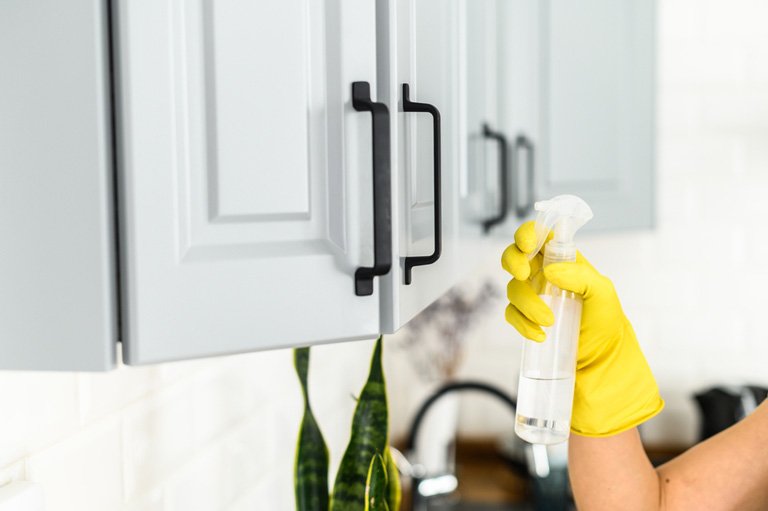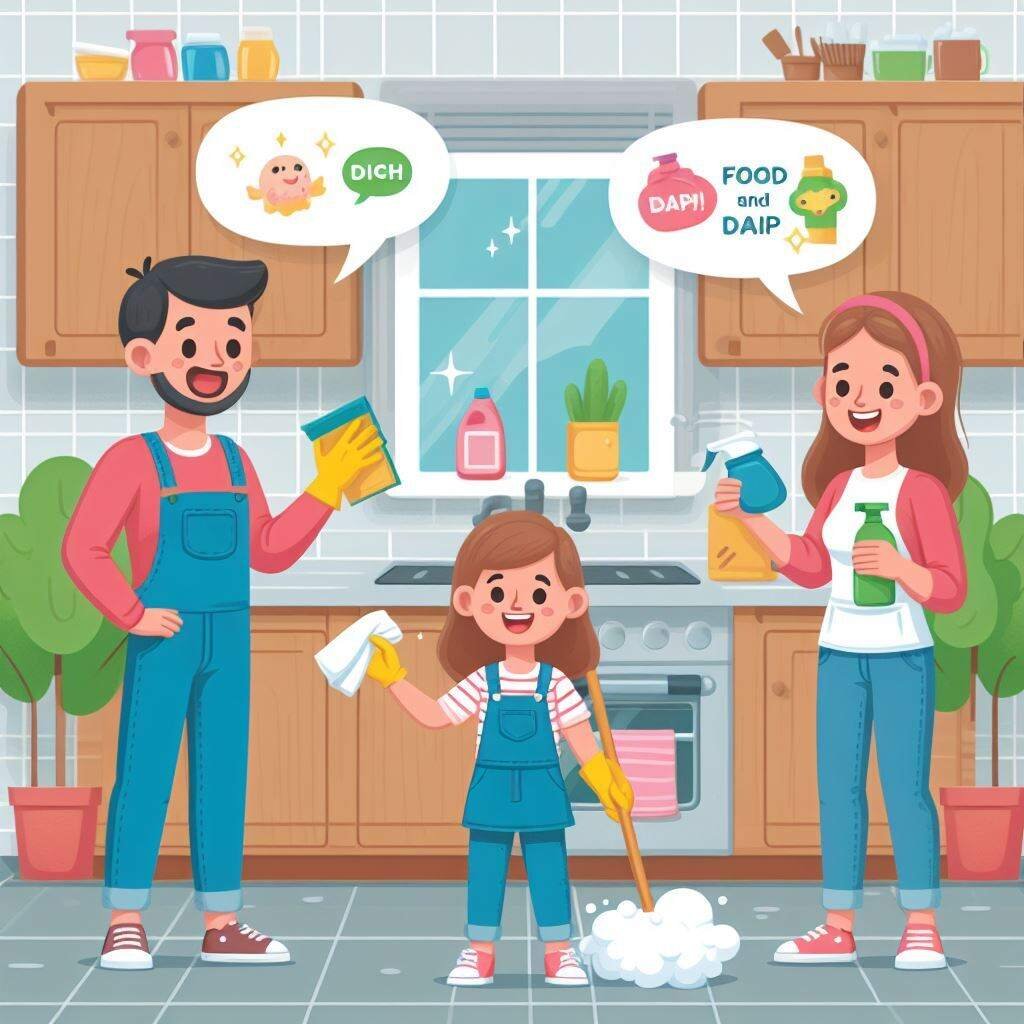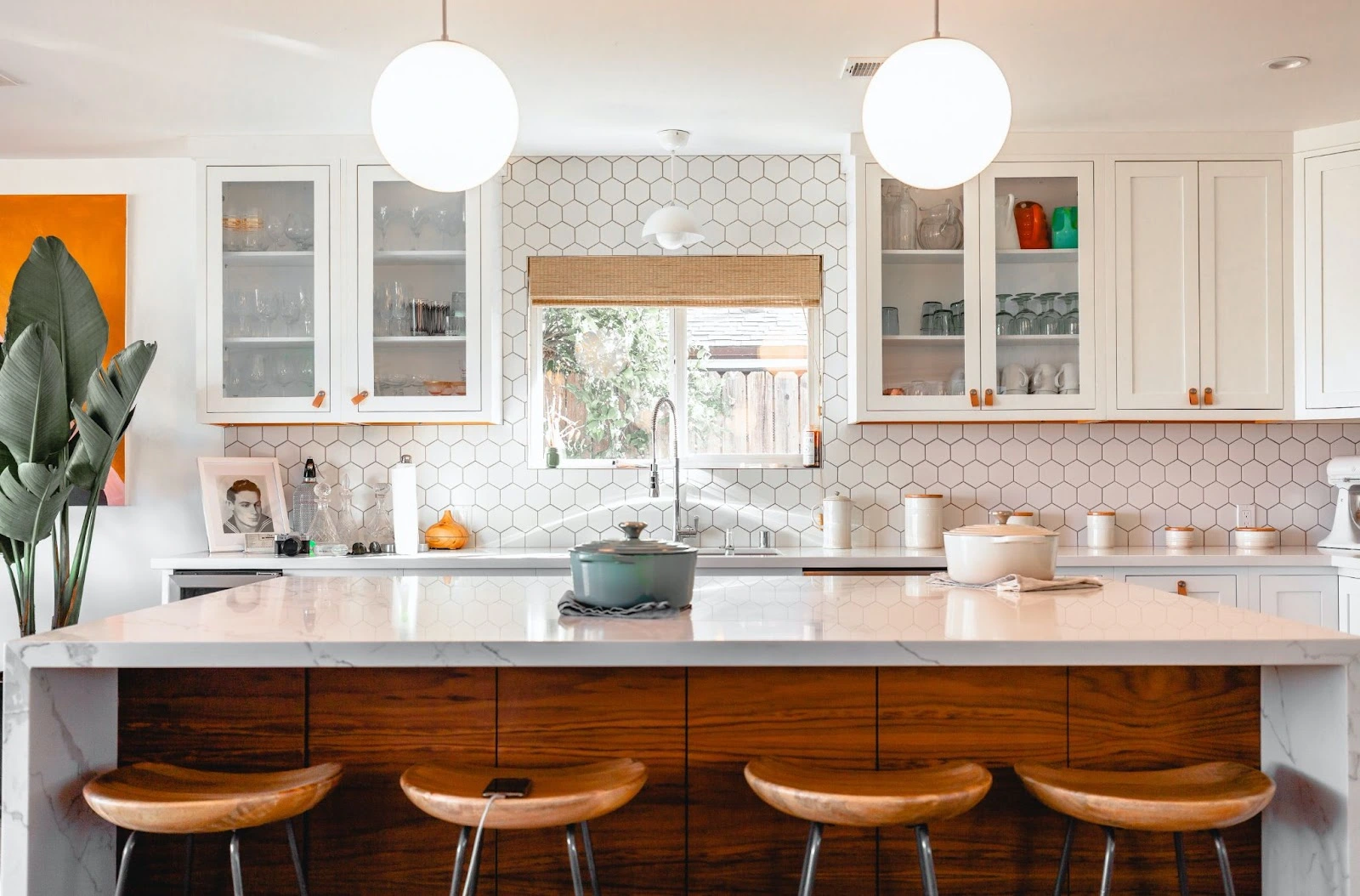Cleaning Kitchen Cabinets: Many homeowners find it tricky to keep every nook and corner of their kitchen clean and maintained. Indeed, it can be daunting for those who take their hygiene and environment seriously.
Furthermore, kitchen cleaning is more of a task when you love to cook for your loved ones. Your cabinets must face lots of splatters, oily stains, and stew from cooking. That’s why keeping the cabinets clean from inside and outside becomes mandatory.
Moreover, we all suggest a daily wipe down. But, the question is, do you think scrubbing and using cabinet cleaner or particular agents will do the trick? No! Sometimes excessive cleaning and the wrong type of toxic cleaner can damage the beauty and quality of your wooden cabinets.
Therefore, we provide an ultimate guide to Cleaning Kitchen Cabinets and cupboards using homemade ingredients. This blog will cover how to clean wooden cabinets, wall cabinets, base cabinets, glass door cabinets, drawers, and more using natural ingredients. Moreover, you’ll learn how to disinfect your kitchen cupboards at home.
Yes, of course. Regular cleaning is a must, but let’s dive into the Cleaning Kitchen Cabinets

Cleaning Wall Cabinets
Cleaning the exterior of your cabinets on a weekly or bi-weekly basis is mandatory. It’s also good to thoroughly clean your cabinets every few months. But, do you know how to clean wall cabinets? If you start emptying one cabinet at a time, you’ll be able to get the job done in a more manageable manner.
For instance, if all of your plates are currently in the dishwasher, you can take advantage of the time to clean the area where they usually sit. As you clean, make a note of what you’ve accomplished.
The Equipment and Tools You need
Equipment/ Tools
- Cloths for cleaning
- A rusty old brush.
- Vacuum (optional)
Material
- Dish soap.
- Solution of vinegar and warm water
- A cleaner with orange oil or a special cabinet cleaner is needed.
- Baking soda (optional)
Prepare your solution using dishwashing soap and warm water, and start cleaning wall cabinets from top to bottom. Remove the cabinet cleaner with a damp cloth as leaving water on the surface can damage or discoloration. Then wipe the knobs and handles. If the grease or sticky material does not come off quickly, apply the mixture and let it stay for a few minutes.
Use a damp cloth to clean up once again. Hopefully, the solution will de-grease the stains and sticky spots. Empty the drawers and clean them from the inside. Use an old toothbrush to clean the edges and inserts of the door profile. Everything that attaches to your wall cabinets should be cleaned by now.
Cleaning Base Cabinets
Generally, we focus on cleaning the wall cabinets as we use them most of the time. But do you realize that your base cabinets also get a lot of dust, grime, and grease from regular cooking? The base cabinets attract more dust particles, spills, and splatters than you can imagine. Don’t believe me! Open your base cabinets right now and see if it needs cleaning.
I’m sure you clean your kitchen floor every day. Right! Therefore, it is time to spare a few hours to learn how to clean base cabinets this week. This maintenance is mandatory as bacteria can grow on the knobs, handles, and inside your base cabinets. Follow the cleaning tips step by step; it will surely help you clean base cabinets in less than an hour.
- Empty the base cabinets
- Make a mild cabinet cleaner with soap and water
- Clean the boxes and shelves
- Go hard on greasy marks
- Use a damp cloth for deep cleaning
- Let the base cabinets dry
- Clean the contents of the cabinets
- Put everything back and clean the doors
Shaker Cabinets and Their Cleaning:
The elegance and genuine beauty of shaker cabinets are sure to impress anyone. But, do you know how to clean shaker cabinets and maintain their ultimate look? Indeed, this cabinet style is available in various colors, sizes, designs, and finishes; but you have to put some effort into cleaning. Let’s see how:
Here is a weekly cleaning regime outlined below:
- Combine 12 cups water, 12 cups all-purpose cleaner, and 14 cups wood cleaner in a spray bottle.
- Now apply the mixture to the shaker cabinets.
- Use a sponge to clean the cleaner and a lint-free cloth to wipe the shaker cabinets.
- Do this twice or thrice until dry.
- Finally, use a soft cloth or towel for drying the cabinets.
To Remove Oily and Greasy Stains
Vinegar is your magic option to remove oily fingerprints and greasy stains from your elegant shaker cabinets. So, use diluted vinegar to wipe oily fingerprints as it is deemed the best cleaner for cabinets. Also, use vinegar solution on cabinets close to or above the cooking range. They are the most vulnerable areas that get grease, water, and food splatters daily. But, use a soft cloth to clean shaker cabinets.

Cleaning Wooden Cabinets
Kitchen cupboards, especially wooden ones, get dirty as fast as you can imagine. They have to suffer a lot of wear and tear. Grease, food particles, and dust can build up on the cabinets and be difficult to remove from wooden door profiles. It can make your cabinets dull over time. Therefore, we bring you the best ways to clean wood cabinets.
Baking soda is simply the best cleaner for cabinets to keep the varnish from coming off during weekly cleanings. There is a discussion in many households about whether or not to clean wooden cabinets that much. Some argue that it damages the varnish. And others think cleaning is a must no matter what. Well, polish your cabinets if you think deep cleaning has adverse effects.
Here what is you need to clean wooden cabinets:
- Vinegar
- Salt
- Soap
- Wood cleaner, if needed
- Baking soda
How Does It Work?
First, daily clean your cabinets with vinegar solution. Add salt to vinegar and make a paste for thick stains. In addition, use baking soda if the stains are greasy and sticky. Then apply mineral cleaners to keep the varnish fresh and new. Lastly, sanitize your cabinets with a steam cleaner to maintain hygiene.
Tips for Cleaning Painted Cabinets:
On the face of your cabinet frames, you can see grime, oily hand prints, dust, dirt, and stains. If your cabinets are not semi-gloss painted, you have a problem. So, I dropped some coffee on my pastel-painted cabinets. Yes, it was daunting as I feared the paint would come off. But, you know what! My mother’s ever-popular cleaning formula saved the day for me. Here is how to clean painted cabinets:
Ingredients you need:
- Dish soap
- Warm water
- A mixing bowl
- Microfiber cloths
- A step stool, maybe
- White vinegar
- Baking soda
Follow the Steps Below:
- Start by mixing up the dishwashing soap in warm water.
- Then dip the microfiber cloth in it.
- Gently apply the mixture and scrub it on the cabinets.
- Now take another wet cloth and wipe the painted cabinets.
- Use a dry cloth, but keep a soft touch.
- Clean tough stains with white vinegar and baking soda; that’s it!
Glass Cabinet Cleaning:
A kitchen with glass cabinets can appear spacious, bright, and welcoming. The glass door cabinets can shine like new with a bit of maintenance. But, most homeowners rely only on commercial glass cleaners or simply clean with plain water. So, do you know how to clean glass cabinets with homemade solutions? If you wish to enhance the visual impact of your cooking space, try these methods for basic and deep cleaning.
Cleaning glass cabinets requires the following materials:
- Water
-
- Vinegar
- A commercial glass
- cabinet cleaner
- Two Lint-free cloths
- Lemon juice
- Spray bottle
- For basic cleaning:
Start by emptying the glass cabinets—dust off the cabinets inside and out. The next step is spraying the solution on glass doors (inside if you have glass shelves). Use the lint-free cloth to clean until dry. Let the glass dry and see the results.
For Stained and Greasy Glass Cabinets
Mix vinegar in warm water and add some lemon juice to it. Mix it in a spray bottle and apply it to the glass doors. Hopefully, the stains will come off quickly since this particular mixture is deemed the best cleaner for cabinets. Use a lint-free cloth to wipe the grease and stains. Try this again and again until the glass shines. Alternatively, use an excellent commercial glass cleaner if vinegar does not work.
Cleaning Laminate Cabinets
Okay! So, we discussed whether or not to invest in laminate cabinets. We have a temporary residence, so we decided not to invest in wooden cabinets. Laminate sounded a great option.
Unlike wood, laminate does not have a porous surface. Temporary or permanent, you cannot go without cleaning them. The good news is that their cleaning isn’t as hard as you think. You need to follow a few basic cleaning steps to get them sparkling. Here are a few basic steps on how to clean laminate cabinets:
Four Steps to Basic Cleaning:
- Dust it off:
- Wash them with mild soap:
- Rinse them with clear water:
- Dry them with a soft cloth:
For Tough Stains, You Need:
- Vinegar
- Baking soda
- Warm water
- Damp cloth
- Soft cloth
- A mixing bowl
Procedure:
Mix 1 cup of vinegar in 2 cups of warm water. Soak a clean cloth in the solution for 3-to 5 minutes and apply with a damp cloth on the greasy stains. Scrub it if it’s a sticky material and wipe if it comes easily. Rinse with warm water and use a soft cloth to dry. You can also apply a paste of vinegar and baking soda to the grease marks. Both the cleaning hacks will work perfectly on any tough stains.

Cleaning Metal/Steel/Aluminum Cabinets
It is Irrespective of whether you have metal, steel, or aluminum cabinets. They should all be cleaned regularly. Cooking food, making coffee, and a busy kitchen leaves marks on the cabinets and kitchen countertops. But, you should know how to clean metal, steel, and aluminum cabinets.
For metal, steel, or Aluminum, you need:
- A towel
- Dishwashing soap (for Aluminum)
- Ammonia solution (for steel)
- White vinegar (for metal)
- Soap with olive oil
- Some salt
For Aluminum: Simply wet a towel in soap or detergent and wipe the cabinets daily. Add some vinegar if the cabinets are greasy or have sticky stains. Vinegar & detergent in lukewarm water should make the best cleaner for cabinets. Avoid aggressive cleaning agents on Aluminum.
For steel: use a soft cloth and a mild soap for basic cleaning. Add ammonia solution to warm water for sticky stains. Follow a specific ratio when adding acids like nitric acid to the solution.
For metal: water and soap will suffice for regular cleaning. Vinegar and warm water are best for removing stains and oily marks. For hardware, use chlorine and bleach in fixed proportions in hot water. Also, use an old toothbrush to rub the grease marks.
Note: use gloves when working with chlorine or bleach.
Cleaning the Top of Cabinets:
Can you ignore the top of your cabinets? Hopefully, you don’t! As much as the front and inside cleaning is critical, the cabinets’ top mostly goes unnoticed. That is why we thought of covering the subject this time. If your cabinets have empty top space, it’s time to learn how to clean the top of cabinets.
Once you dust off the cabinet tops, follow the steps below and get it done.
- Your cabinet tops probably have a thin layer of filth or oily particles up till now. So, first of all, improve the airflow of your kitchen by ventilating the place.
- Now use salt and vinegar on a microfiber cloth to clean the greasy layer of dirt.
- Again use a slightly wet dusting cloth to wipe the cabinet tops.
- Wax paper is also a great alternative. Use wax paper to wipe all of that greasy dust in one go.
Cleaning Cabinet Interiors:
So, now you know how to clean glass cabinets, painted cabinets, laminate cabinets, base cabinets, and cabinet tops. Let’s talk about the interiors of cabinets. Indeed, it is not easy to clean the inside of cabinets every week. You probably clean your entire kitchen monthly or after every two-three months. That’s great! But, do you need more tips on how to clean the inside of cabinets?
Follow the Steps:
1. Empty the Cabinets:
Take out every single item from the cabinets and sort them properly.
2. Remove the Drawers and Shelves:
Furthermore, remove the shelves and drawers if removable.
3. Use a Non-Abrasive Detergent in Warm Water:
Mix a non-abrasive detergent in warm water and apply it inside the cabinets and on the shelves.
4. Clean It Twice Until It Dries:
Wipe and clean inside the cabinets again and again until it dries. Then use a dry cloth to make sure there is no water content inside that may damage it later.
Preventing Oil and Food Staining:
Cleaning Kitchen Cabinets: Cleaning stains and oily marks are one thing. But do you realize you can prevent your cabinets from developing permanent food and oil stains? So, take the following precautions and know how to prevent oil and food staining on cabinets.
- Remember, clean hands and fingers mean clean cabinets. Try to keep your oily fingers away from cabinet doors.
- Get a good cooking range with a preventive hood. It will prevent your cabinets close to the stove from being safe from oil droplets.
- Opt for gloss or semi-gloss cabinets. this cabinet finish prevents staining a lot
- Use wax paper; it is a great solution to clean cabinets and prevent oily and food stains from sticking to the cabinets.
Learning to Disinfect Your Cabinets:
Do you really think just cleaning cabinets and kitchen is enough during such dreadful infections? It has been two years since we have been disinfecting our homes. Therefore, cleanliness is as critical as sanitizing your cabinets. The dirt accumulated on your kitchen surfaces will lead to germs. So, it’s time to learn how to disinfect/sanitize your cabinets.
Follow these disinfecting steps:
- Fix a time for disinfecting
- Prepare yourself if you are using toxic chemicals for disinfecting
- Use what suits your cabinet finish
- Use disinfecting wipes or bleaching wipes to sanitize the cabinets.
- Be mindful of using gloves when applying bleach or other acidic disinfectants.
Importance of Cleaning Cabinets and Kitchen Cupboards
Like your kitchen counter and sink, kitchen cupboards are the hub of dirt and sticky particles. That is why, in your kitchen, cleaning kitchen cabinets from inside and outside is essential. If you can feel the sticky handles and knobs with unwanted food stains, you might be neglecting the hygiene of your kitchen space. It would be best if you did not ignore something directly connected to your health. Let’s see why it is important to clean cabinets:
- Hygiene is maintained by cleaning
- Regular wiping and dusting are mandatory
- Deep cleaning eliminates germs
- Cleaning makes them last longer
- Using natural elements helps disinfect them
- A monthly deep cleaning is the best
Cleaning and Lubricating Cabinet Drawers:
Is your cabinet drawer slide sticking? Try lubricating it. The smoothness of all hardware can be lost over time. In the same way, you might notice some hiccups in the movement of your drawer slide after years of use. But, replacement should only be a last resort. Cleaning and lubricating your cabinet drawer slides and ball bearings is the first step.
Have no idea how to clean and lubricate the drawer slides! Use these steps to restore the slide’s finesse.
- Start by separating the drawer members. An immediate opening sound will ensure the separation of the slides.
- Clean and wipe the slides one by one. And move the ball retainer to clean the slides thoroughly.
- Now spray a water-based cleaner on the slides and wipe with a soft cloth or towel. Be careful when wiping the drawer slides.
- It’s time to apply the joint grease on the slides while moving the ball bearing back and forth.
- Reinstall the slides after cleaning and greasing them. Finally, fix the drawer slides.
Homemade DIY Solutions for Your Cabinets:
Do DIY solutions work for you? Have you ever made one at home? If not, this is the right time to try these DIY cleaning solutions at home. Trust me; it’s a fun and frugal activity. The good part about using these homemade solutions is that you always have those natural ingredients in your kitchen. For instance, vinegar, lemon, and baking soda are the staple ingredients of your cooking space. So, why not skip those harsh cabinet cleaners and try the best cleaning solution for your cabinets that are easy to prepare?
What would you need to make these DIY solutions:
- vinegar
- lemon juice
- baking soda
- essential oils
- lemon rind
- warm water
- spray bottle
- sponges
- microfiber cloth
- an old toothbrush, maybe
You can prepare an all-purpose cabinet cleaner using two parts water, two parts vinegar, and lemon rind. Combine everything in a spray bottle and keep it for a week. Shake well before spraying and see all the dirt and oily particles wipe away in seconds. The lemon rind will leave a soothing smell and a shiny cabinet surface. The good news is that you can use this DIY solution in all kitchen areas, including the sink, countertops, and microwave.
In addition, always add some baking soda to your homemade cabinet cleaner if you are dealing with grease and sticky food particles. Use a sponge or an old toothbrush to scrub the greasy marks. Also, use these solutions on your sticky handles and knobs for a thorough cleaning. Add essential oils to enjoy a nice dewy odor after cleaning kitchen cabinets

Removing Stains from Your White Cabinets
Indeed, nothing can beat the glorious look of a white kitchen cabinets. What’s more appealing than white cabinets, white tiles, floors, walls, and stainless steel appliances? But, the white kitchen demands many cleaning regimes.
Many homeowners don’t like the idea of having white cabinets due to their cleaning. Well, that’s a misconception. A few cabinet cleaning hacks and DIY solutions can go a long way. Let’s see how can you remove stains (greasy, oily, and dirty) from white cabinets:
First, regular cabinet cleaning is a must – so dust it off and use dishwashing soap in warm water for daily cleaning. Also, add lemon juice to remove ketchup or coffee stains.
For greasy and sticky stains, you need:
- vinegar
- baking soda
- damp cloth
- a soft dry cloth
Clean the tough and greasy stains with vinegar and baking soda paste. Scrub and clean these spots with a damp cloth. Once more, dampen a cloth in vinegar and wipe the stain from your white cabinets. Clean the area thoroughly with water and dry with paper towels. Enjoy a spotless white kitchen!
FAQs:
-
What cleans grease off of the cabinets in the kitchen?
Mix some baking soda, warm water, and lemon juice to make a cleaning mixture. Put the solution in a spray bottle and spray the liquid on the cabinets. Leave it for 2-3 minutes and allow the baking soda to work. Gently scrub the grease away with the sponge.
-
What is the best cleaner for white cabinets?
Use 1 cup vinegar, 2 cups warm water, and one tablespoon baking soda to clean your white cupboards. Clean your cabinets once a month with warm water and grease-fighting dish soap.
-
What is the best cleaner for wood cabinets in the kitchen?
Fill a spray bottle with a 50/50 vinegar-warm water solution. Apply a soft cloth to cabinets and wipe them clean after a few minutes. Add a few drops of liquid dishwashing detergent to extremely dirty cabinets to the vinegar and water solution.
-
What to use for cleaning cabinets?
Vinegar is the most natural ingredient for cleaning cabinets. The kitchen has grimy cabinets that can be cleaned with 50/50 vinegar and a warm water solution. Clean it top to bottom and see how it works.
-
Can I use bona hardwood floor cleaner on cabinets?
Bona Power Plus Wood Surface Cleaner is best for cleaning wood cabinets. One can easily clean grease and grime with hydrogen peroxide’s powder to dry fast and leave no residue. You can also remove fingerprints, and your family can use them without worry.
-
Is murphy oil soap good for cleaning cabinets in the kitchen?
In addition to breaking up dirt particles, Murphy Oil Soap is safe for wood products like wooden cabinets. Pour 1/4-1/2 cup of the oil soap into a gallon of warm water, depending on how deep or mild your cabinets need to be cleaned.
-
Is TSP good for cleaning kitchen cabinets?
TSP is good and effective for cabinets if they possess mold, mildew, and intense grime. Mix it with a little bleach and apply it to the stubborn stains. It will eliminate the oily and greasy marks.
-
How do professionals clean kitchen cabinets?
Prepare a cleaning solution with warm water and vinegar in equal quantities. Dip a sponge in the solution but do not apply the dripping sponge to the cabinets. Use a microfiber cloth to wipe the cabinets until dry. Repeat the process if you have to, and run the cabinet faces gently. That’s how professionals clean cabinets in the kitchen.
-
How do you remove grime from cabinets?
For grime, mix I tsp. of white toothpaste in a cup of water. Add two tablespoons of baking soda and mix it well. Now dip a sponge in the solution and apply it to the grimy areas. Wipe it off until the sticky residue disappears.
-
How do I make my kitchen cabinets look new?
Paint, reface, or use silicone-free wood polish to make your cabinets look new. Also, make a habit of regular cleaning kitchen cabinets to keep them shining.
-
Can you use Windex on wood cabinets?
A little Windex can make your kitchen look bright and clean. You can use it on the stainless steel appliances and sink area, but ammonia in Windex can damage wooden cabinets. So, keep it away from natural wood and glass surfaces.
-
Why are my cabinets sticky after cleaning?
It is normal to have greasy cabinets in a busy kitchen. However, it may be the cleaner or something else that left the sticky residue even after cleaning. Therefore, always use warm water for cleaning kitchen cabinets and add lemon juice to remove the sticky residue.
-
How often should you clean your cabinets in the kitchen?
With regular maintenance, experts say you should clean your cabinets every 3-4 months. However, excessive cleaning with drenched sponges is not a good idea as it will damage your wooden cabinets.







